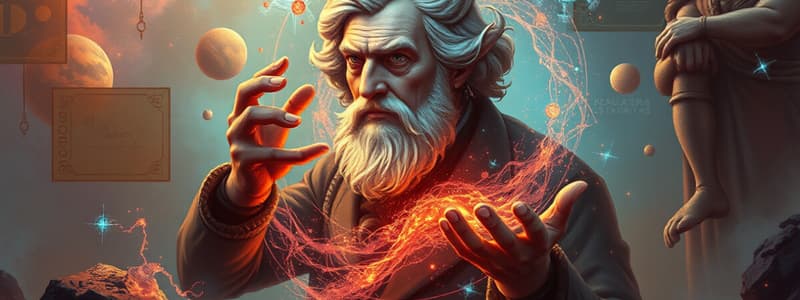Podcast
Questions and Answers
What are all substances made of according to John Dalton?
What are all substances made of according to John Dalton?
atoms
According to John Dalton, atoms of different elements are exactly alike.
According to John Dalton, atoms of different elements are exactly alike.
False (B)
Who discovered the first subatomic particles?
Who discovered the first subatomic particles?
J.J. Thomson
J.J. Thomson referred to his atomic model as the ______ model.
J.J. Thomson referred to his atomic model as the ______ model.
What particle did Ernest Rutherford discover?
What particle did Ernest Rutherford discover?
What determines the type of atom?
What determines the type of atom?
What refers to the total number of protons and neutrons in an atom?
What refers to the total number of protons and neutrons in an atom?
What are valence electrons?
What are valence electrons?
No two elements have the same number of protons.
No two elements have the same number of protons.
What happens to electrons when they gain energy according to Niels Bohr?
What happens to electrons when they gain energy according to Niels Bohr?
Who developed the electron cloud model?
Who developed the electron cloud model?
Isotopes have the same number of protons but different numbers of ______.
Isotopes have the same number of protons but different numbers of ______.
What is the unit of measurement for subatomic particles?
What is the unit of measurement for subatomic particles?
Study Notes
Modern Atomic Theory
- John Dalton: Proposed that all substances are made of atoms which cannot be created, divided, or destroyed. Introduced the Solid Sphere Model, where atoms of the same element are identical and different elements vary in mass and size.
- J.J. Thomson: Discovered the first subatomic particles, specifically electrons. Created the Plum Pudding Model, depicting atoms as spheres filled with positive matter and embedded with negative electrons.
- Ernest Rutherford: Discovered the nucleus of the atom. His Nuclear Model identified a small, dense, positively charged proton at the nucleus’ center, with electrons orbiting it; the exact position of electrons remains uncertain.
- Niels Bohr: Introduced the concept of energy levels for electrons, theorizing that electrons travel around the nucleus in fixed paths and can jump between energy levels.
- Erwin Schrödinger: Developed the Electron Cloud Model, suggesting that the exact path of electrons cannot be predicted. Electrons are found within a probabilistic region known as the electron cloud.
- James Chadwick: Discovered neutrons, which are electrically neutral and have mass nearly equal to protons. Introduced the atomic mass unit (amu) as a measurement for subatomic particles.
Modern Theory of the Atom
- Atoms consist of three primary subatomic particles: electrons, protons, and neutrons.
- Most atomic mass is found in the nucleus, where protons and neutrons are present; electrons reside outside the nucleus.
- In stable atoms, the number of protons equals the number of electrons, determining the type of atom and its atomic number.
- The atomic mass is the total number of protons and neutrons and is measured as atomic mass.
Periodic Table
- Elements are organized by atomic number, indicating the number of protons, which is unique to each element.
- Atomic mass represents the "weight" of an atom, calculated by adding the number of protons and neutrons.
- Isotopes are variants of an element with the same number of protons but different numbers of neutrons.
- Valence electrons are found in the outer energy level and are responsible for chemical bonding.
Properties and Predictions
- The position of an element in the periodic table provides valuable information regarding its physical and chemical properties.
- Predictive capabilities exist for the reactivity and interactions of elements based on their location within the table.
Studying That Suits You
Use AI to generate personalized quizzes and flashcards to suit your learning preferences.
Description
Explore the foundational concepts of Modern Atomic Theory as proposed by John Dalton. This quiz covers key principles such as the nature of atoms, their indivisibility, and the formation of new substances. Test your knowledge on the fundamental building blocks of matter.




